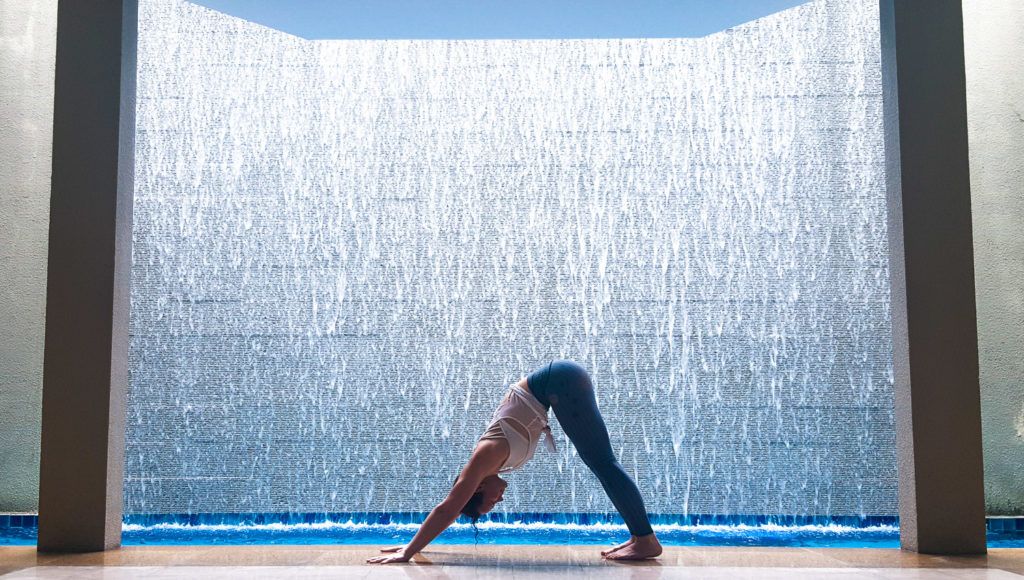
Yoga, which means “to yoke or join the mind, spirit, and the body,” originated in India over 2000 years ago.
Here are a few tips for people brand new to Yoga, or considering trying it out, but not sure if it is for them.
- You don’t have to be able to touch your toes.
“But I’m not flexible, I could never do yoga!” is the bane of our society. If you can breathe, you can practice yoga. While you may not be able to touch your toes, yet, it IS about what you learn on the way down there. - Not all yoga is created equal. There are many different schools, types, and styles of yoga. Some are powerful and physically challenging workouts with headstands and arm balances. Some are more spiritually focused and meditative. Some are purely stretching, relaxing and restorative.
Do try many and see what you like. Teachers are different in their style so explore to find what you like.
- Breath is a key component. Breathing is a fundamental thing we do daily without thinking, so how different or critical can it be while yoga-ing? INCREDIBLY! In an advanced practice, you will learn to master it, especially in challenging poses. See this breath work article here. You may notice over time how much it can help you to improve your performance in all aspects of your life, work, yoga practice, sport and everything else in between.
- Speaking of other sports, yoga is a perfect complement. Runner, crossfitter, tennis, golf? Whatever your main jive, adding yoga to the mix perfectly complements other types of workouts leading to an inward and outward transformation. Incorporating yoga stretches and poses into a routine can give a profound physical, mental, and spiritual awareness.
- It’s also not as easy as you may think.Practically everything you do in yoga is engaging your core, from core-centric poses to smooth transitioning from pose to pose, using your core to stabilise your body. Cardio? Try doing a few rounds of sun salutations without working up a good sweat! Check out this Sun Salutation here.
- You Don’t Have To Do Handstands.
Yes, they are incredibly fun, but they are not required! It is important to build up to headstands and handstands, it could take years, as it did for me. Don’t expect to be able to do it on day 1. Yoga is about the journey. There is no destination. Practice patience! After all, it is ‘yoga practice, not yoga perfect!’. - Fun fact: Yoga incorporates all planes of movement to the body. You will move in all planes of the body to benefit a range of motion, prevent injuries and provide greater stability for your body. It also utilises backbends, or extension of the spine, to keep the spine supple and young. Backbend poses help open the chest, increase flexibility and stimulate the nervous system.
- On that note, being really bendy is not yoga. The ability to contort your body into a pretzel or other curly shapes is not what it’s all about. The key is doing poses safely for your body type.
There is a myth that being more flexible is a sign of a good yogi, however, the more flexible a person is, the more prone their ligaments are to injury in yoga because they lack stability. Conversely, those who are stiff need to increase their flexibility so the pelvis and spine can move freely and avoid compression during activities of daily living.
- Yoga is the opposite of competitive. Every body type is different and we are all unique in our own way. Own it! Try to avoid looking around to see if your pose looks like other people’s poses. It is not a competition with the yogi on the next mat, nor with ourselves! That being said it is not bad to have goals to achieve, or intention, but it shouldn’t be about ‘achieving a certain pose’, or an Instagram-able pose, and forsaking your body or compromising where you are right now because that is where injuries happen.
- Yoga is more than a physical practice.
Mindfulness and honouring your present moment is key to yoga. Every day is different and some days it can be difficult to step onto your mat. We often live in our thoughts or worries, thinking about the past or projecting future events. The more we live in the moment, the less fear and anxiety we experience.You are challenged to ground down and root yourself into the present, sometimes it’s not easy and we don’t like what we see. Whatever arises in us is real, recognising it without judgment is important to help stop our raging minds and just be.I find however I am reacting to things on my mat, is a mirror to how I am reacting in my present moment of life. If the mind is distracted, the breath is ragged or if your ego takes over to get you there, then the yoga is lost.
- Savasana is the most important part of the practice!!!Training your mind to be still as mentioned above, is not an easy feat.In savasana, you lie down supine on your mat and allow your whole body to relax. However, when we slow down, this is when the mind seems to speed up. Observe any thoughts that enter your mind and then let them float away. If you are having a hard time letting go, focus on the rhythm of your breath.
Let yourself go and you will be surprised at what you can discover by allowing yourself to slow down momentarily.
- Don’t be afraid of saying Namaste.
By uttering it you are not pledging allegiance to a cult or negating your own religious beliefs. You are simply doing what the word says you are doing; honouring your fellow yogis and recognising your human connection.“Namaste” very simply means, ‘the light in me, honours the light in you’.
